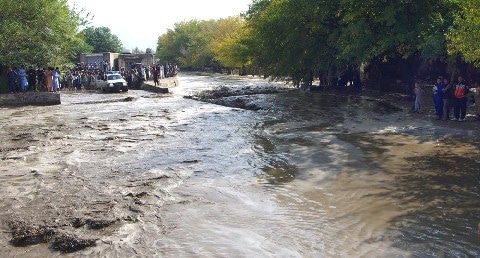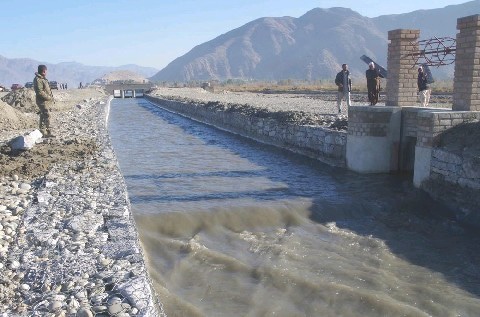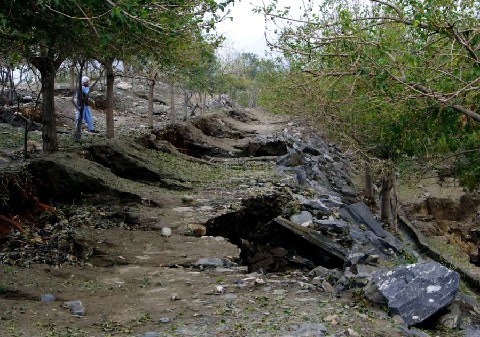【In the land of the Afghans – Reports from Dr. Tetsu Nakamura】Severe drought robs people of their livelihoods and lives
Published on December 3, 2018 - The Nishinippon Newspaper
The spring of 2018 witnessed little rainfall in eastern Afghanistan after a warm winter - a pattern that has repeated itself for the past three years. Local residents looked up with anxiety at the snow on the high mountains. The land is becoming increasingly dry at an accelerated pace. In April, UN agencies such as UNICEF (United Nations Children's Fund) and WFP (World Food Programme) drew attention to what they said was a severe drought which only occurs once in decades with the possibility of over one million people at risk of starvation. In reality, from long before, chronic starvation has impacted upwards of 7.6 million people according to the WFP (2014). Therefore, the three consecutive years of abnormally low levels of precipitation have only worsened the situation.
■Displaced from home villages
Even after the summer months, the low level of rain continued, exacerbating the disaster. In June 2018, the OCHA (Office for the Coordination of Humanitarian Affairs) emphasized the severity of the situation, reporting that 8.3 million people were at risk of starvation, and 3.3 million faced death from it. By that time, drought had spread across the country, with food crisis alerts raised in 20 out of the 34 provinces.
The southern and western regions of the country, where there are no large rivers, were most severely affected. A record heatwave hit from June to July causing wells to run dry in areas of Herat in the west, and Helmand, Farah, Nimroz provinces in the south. Local residents began to abandon their villages and became displaced. In September, the British Broadcasting Corporation reported that over 260,000 people were displaced, but this figure is only the tip of the iceberg. A far larger number of people on the verge of displacement still remained in rural villages.
The water supply of the Helmand River, which is the water source for the entire southern region, dropped sharply impacting Kandahar’s traditional underground waterways - the Karez. In October, the leadership of the Taliban issued an unusual proclamation, appealing for relief for displaced persons. Yet, emergency food distributions compared to the scale of needs were only a drop in the ocean.
■A disaster missed by the media
PMS (Peace Japan Medical Services) operates in eastern Afghanistan’s Nangarhar Province, where the drying of the land is accelerating rapidly. The majority of villages situated in the Spin Ghar mountain range on the border with Pakistan have turned into soil deserts Nevertheless, the Kunar River, which originates in the 7,000-meter-high Hindu Kush range was considered safe. However, anomalies in river water levels have been recorded since last winter, suggesting abnormal changes in alpine snowmelt levels. Around the same time in Nuristan Province, further upstream, spring water began to dry up, signaling a famine.
Usually, many displaced people flee to Pakistan but Pakistan has no room, and deportation of Afghans is underway. There is nowhere else to go. In the eastern region, Nangarhar Province has the largest population, anxiety is turning into fear as farmland becomes desert, apart from a few minor areas alongside major rivers.
Yet, the drought remains a blind spot in the news. There are no dramatic scenes like those associated with earthquakes or war because population displacement is gradual. Drought victims do not immediately leave their villages but try to avoid starvation by becoming migrant workers. Death from starvation does not have a name as a disease, despite the increase in the number of deaths due to malnutrition. Population displacement that has taken place over several years is unlikely to be reported as a news incident. The situation is totally different from droughts on large scale farms in North America. In Afghanistan, livelihoods and lives are lost, not food as a commodity.
■A reconciliation between humanity and nature
Following the major drought of 2000, PMS has been implementing the Green Ground Project since 2003. Nine intake weirs and tens of kilometers of canals have been constructed to guarantee the lives of 600,000 people. However, the area has been experiencing an abnormally high population concentration since three years ago. People have been flocking in from the devastated areas in and around Nangarhar Province, with the hope of whatever little income that they can get. It is estimated that the population of the region will exceed one million.
Currently, PMS is promoting the intake weir extension plan at a rapid pace, but as far as the eastern region is concerned, the water volume of the major rivers has not decreased much. Along with planting crops resistant to drought, it is necessary to expand sustainable irrigation areas on a scale that does not significantly affect neighboring countries while restoring agricultural production. Even if the whole country does not benefit, it will reduce the number of refugees and curb rising food prices.
If we, as humans, are standing on the edge of an abyss, or if the apocalyptic situation affecting Afghanistan spreads throughout the world, we won’t know until it happens. However, even if there are extreme inferences in the debate on global warming, I do not think it is right to deny the reality before us. The global movement is not only about temperature rises. It is a constructive movement that tries to rethink modern production methods which are based on the burning of fossil fuels, seeking a sustainable and stable society, and restoring the natural environment. The situation has been reported as so critical, that we cannot picture the future without this movement.
It is an issue that affects us all. That is why PMS advocates for "Food self-sufficiency, not war" in Afghanistan and promotes the importance of "Reconciliation between peoples, and between humanity and nature."
× ×
This is a translation of a report from Afghanistan by Dr. Tetsu Nakamura, a Japanese medical doctor who was gunned down on December 4, 2019 in Afghanistan at the age of 73. Dr. Nakamura was the head of the international NGO, Peace Japan Medical Services (PMS). In addition to medical services, PMS provides various forms of assistance to local communities in Afghanistan’s eastern Nangarhar province, including the construction of irrigation systems, related agricultural programming and provision of food support. PMS is funded by Peshawar-kai, which was established in 1983 to collect donations from people and support the project implementation of Dr. Nakamura and his team.
This report is one of 27 installments in the series “In the Land of the Afghans – Reports from Dr. Tetsu Nakamura,” which ran from May 25, 2009 to December 2, 2019. They were originally published by the local newspaper in Dr. Nakamura’s hometown in Fukuoka, Japan. The text has been translated from Japanese to English, with the support of Peshawar-kai, by more than 30 volunteers, many of whom work in the field of humanitarian and development aid, and who have been and will continue to be inspired by Dr. Nakamura's work and philosophy.






